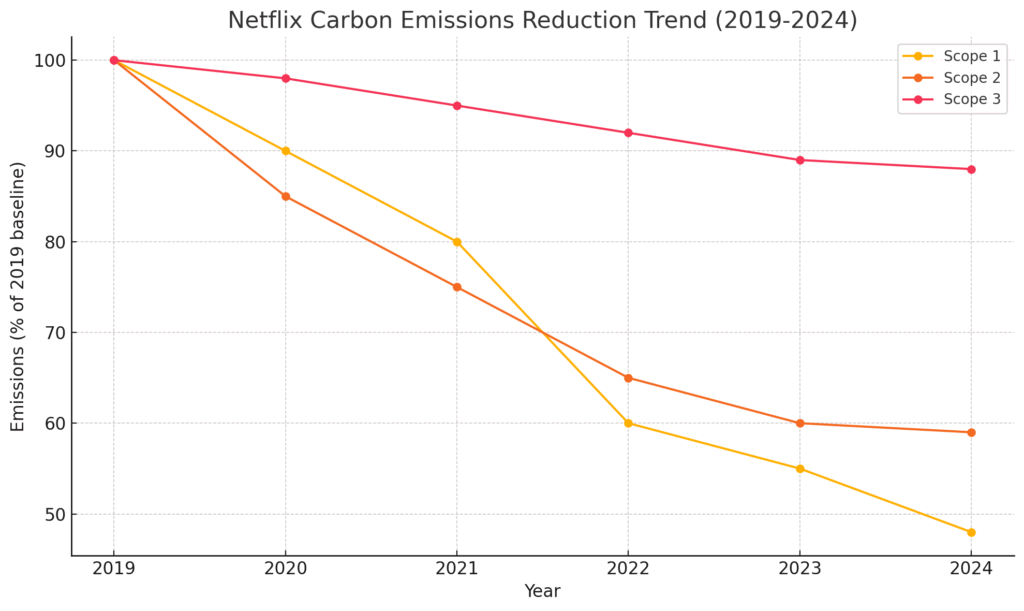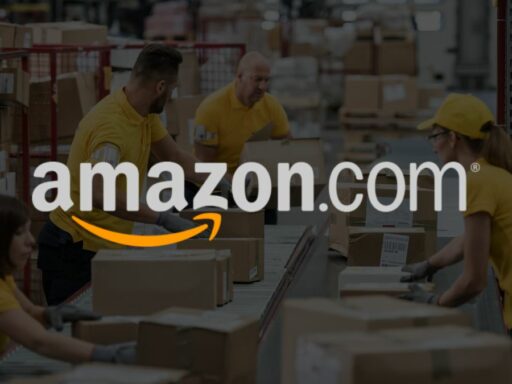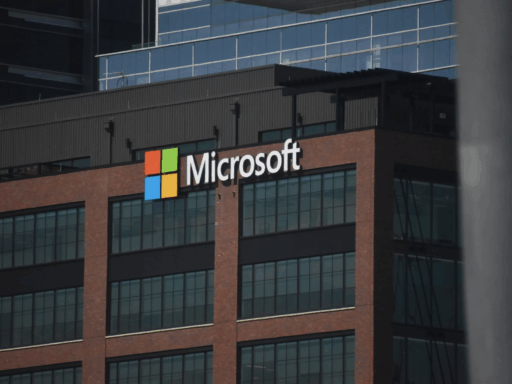- Sustainability Strategy and Goals
- Packaging and Circular Economy
- Human Rights and Responsible Sourcing
- Community and Social Impact
- Governance and Transparency
- Technology and AI for Green Streaming
- Global Partnerships and Advocacy
- Measurable Impact (Data-Driven Results)
- Challenges and Areas for Improvement
- Future Plans and Long-Term Goals (2030–2040 Vision)
- Comparisons to Industry Competitors
- Our Thoughts
Netflix has steadily emerged as a pioneer in the global entertainment industry’s transition toward climate responsibility. As a platform hosting over 270 million global subscribers (as of Q1 2025), its environmental impact extends from vast data infrastructure and content production to the digital carbon footprint of streaming. Recognizing this influence, Netflix introduced a formal environmental strategy in 2021, aligning with the Paris Agreement’s 1.5°C trajectory and aiming for net-zero greenhouse gas (GHG) emissions.
Netflix achieved carbon neutrality across its operations in late 2022, primarily through a combination of direct emissions reduction, renewable energy procurement, and high-integrity carbon credits. Beyond operational emissions, Netflix’s vision includes regenerative impacts, aiming to restore ecosystems that sustain the creative communities it serves.
- In 2024, Netflix reported reducing Scope 1 and Scope 2 emissions by 46% compared to its 2019 baseline.
- 100% of Netflix’s corporate offices and productions have been powered by renewable energy since 2022.
- The company invested in over 20 reforestation and conservation projects across five continents under its “Grow Creative” initiative.
- Netflix’s ESG strategy aligns with 10 UN Sustainable Development Goals (SDGs), including SDG 13 (Climate Action) and SDG 15 (Life on Land).
Sources:
www.un.org/sustainabledevelopment/sustainable-development-goals/
sciencebasedtargets.org/companies-taking-action
Sustainability Strategy and Goals
Netflix’s formal sustainability framework is organized under its “Net Zero + Nature” ambition. It follows a two-pronged approach: reduce emissions internally and support external projects that sequester carbon. Netflix’s targets are approved by the Science Based Targets initiative (SBTi) and are consistent with limiting global warming to 1.5°C.
Net Zero and Carbon Emissions
The company’s operational emissions are segmented into Scope 1 (direct), Scope 2 (purchased electricity), and Scope 3 (indirect emissions, including production and customer device usage).
Netflix’s commitment:
- Achieve net zero GHG emissions by cutting emissions 45% by 2030 relative to a 2019 baseline, and neutralizing residual emissions through nature-based solutions.
- Deploy low-carbon production guidelines across all original content, including mandatory use of electric generators, hybrid vehicles, and sustainable set design principles.
- Engage suppliers through a Sustainable Supplier Program launched in 2023 to address Scope 3 emissions collaboratively.
In 2024:
- Scope 1 emissions reduced by 52% relative to 2019.
- Scope 2 emissions cut by 41%, with full renewable energy matching.
- Scope 3 emissions still account for over 85% of Netflix’s carbon footprint, particularly from content delivery and device energy use.
Sources:
www.netflixinvestor.com/esg-report
sciencebasedtargets.org/companies-taking-action
Water Stewardship
While Netflix is primarily a digital-first company, water use plays a role in film and series production, particularly on-location shoots. Recognizing the growing water scarcity concerns, Netflix adopted water conservation policies for its sets.
Netflix initiatives:
- Implement water recycling systems on major filming locations.
- Partner with Water.org in 2023 to advance access to clean water in production communities in Latin America and Africa.
- Prioritize sourcing of sustainable catering and craft services that use minimal water-intensive products.
Sources:
www.water.org/partners/netflix
www.netflixinvestor.com/esg-report
Regenerative Agriculture and Nature-Based Solutions
Netflix’s commitment to restoring natural systems directly links to its emissions strategy. Rather than relying solely on offsets, Netflix invests in regenerative agriculture and forest conservation to create long-term carbon sinks.
Key efforts:
- Support for mangrove reforestation projects across Southeast Asia, capturing an estimated 500,000 tons of CO2 by 2030.
- Investment in regenerative cotton farming projects for Netflix merchandise collaborations, launched under the “Creative by Nature” line in 2024.
- Partnership with Conservation International to protect 500,000 hectares of biodiversity hotspots in the Amazon Basin.
Sources:
www.conservation.org/projects/netflix
www.netflixinvestor.com/esg-report
Deforestation and Biodiversity
Beyond carbon, Netflix acknowledges the role of healthy ecosystems in global stability. Several high-profile Netflix productions in 2024, such as the documentary series “Earth’s Revival,” were carbon-neutral and contributed to active biodiversity conservation funding.
Examples:
- “Our Planet II” production restored 2,000 acres of degraded rainforest in Madagascar.
- Netflix funded biodiversity research centers in Tanzania and Costa Rica.
- 5% of profits from nature-based documentaries reinvested into habitat conservation projects through a partnership with WWF.
Sources:
www.ourplanet.com/en/news/netflix-and-wwf
www.netflixinvestor.com/esg-report
Packaging and Circular Economy
Although Netflix operates primarily as a digital platform, its physical media merchandise, event production, and marketing materials still generate packaging waste. Recognizing this, Netflix began integrating circular economy principles into its operations starting in 2022, committing to minimize waste at every level.
Key initiatives include:
- Adoption of FSC-certified, 100% recycled materials for all Netflix product packaging since late 2023.
- Partnership with TerraCycle to develop closed-loop recycling programs for promotional items distributed at major events like film festivals and comic conventions.
- Reduction of physical merchandise footprint by 42% between 2020 and 2024, replacing plastic-based gifts with digital experiences such as NFTs supporting conservation projects.
- Launch of Netflix Sustainability Design Standards, mandating minimal packaging and recyclability requirements across suppliers and creative agencies.
By reducing unnecessary packaging and promoting material recirculation, Netflix is taking tangible steps to address environmental impacts often overlooked in the entertainment sector.
Sources:
www.netflixinvestor.com/esg-report
www.fsc.org/en/newsfeed/netflix-sustainable-packaging
www.terracycle.com/en-US/brigades/netflix
Human Rights and Responsible Sourcing
Netflix emphasizes responsible sourcing across its global supply chain, particularly for its original productions filmed in diverse international locations. Its ethical sourcing guidelines align with the UN Guiding Principles on Business and Human Rights.
Important highlights:
- Introduction of a Human Rights Policy in 2023, covering all Netflix employees, suppliers, and contractors globally.
- Mandatory sustainability and human rights compliance checks for vendors, with third-party audits for high-risk geographies.
- Commitment to responsible sourcing for costume and prop materials, ensuring no involvement in forced labor or unsustainable harvesting (e.g., conflict minerals for costume embellishments).
- Launch of the Netflix Supplier Diversity Program, expanding sourcing to historically underrepresented vendors by 18% year-over-year growth between 2022 and 2024.
Netflix also partners with external organizations such as the Responsible Business Alliance to stay accountable to global human rights standards.
Sources:
www.netflixinvestor.com/esg-report
www.responsiblebusiness.org/members/netflix
www.un.org/en/global-issues/human-rights
Community and Social Impact
Netflix understands that sustainability is inseparable from community well-being. In addition to environmental programs, Netflix runs wide-reaching community investment efforts linked to economic empowerment, cultural representation, and digital equity.
Core initiatives:
- Netflix Fund for Creative Equity: Pledged $100 million over five years (starting in 2021) to support underrepresented creators worldwide.
- Netflix Pathways: Scholarship and mentorship programs focusing on STEM, filmmaking, and climate storytelling fields.
- Local Production Investment: Committed over $2 billion between 2022 and 2024 to produce content in countries like South Korea, Nigeria, and Spain, fueling local economies.
- Digital Inclusion: Partnered with Project Connect to improve internet access for rural communities, directly connecting sustainable development with content accessibility.
Sources:
about.netflix.com/en/news/netflix-fund-for-creative-equity
www.projectconnect.world/partners/netflix
www.netflixinvestor.com/esg-report
Governance and Transparency
Strong governance structures ensure Netflix’s sustainability strategy remains credible and action-oriented.
Governance measures include:
- Formation of a dedicated Sustainability Advisory Council comprising internal leaders and external climate scientists, meeting quarterly since 2023.
- ESG performance disclosures following SASB (Sustainability Accounting Standards Board) and TCFD (Task Force on Climate-related Financial Disclosures) frameworks.
- Climate-related financial risk scenario planning integrated into Netflix’s risk management process.
- Public disclosure of climate lobbying activities, ensuring alignment with Paris Agreement goals.
By embedding climate accountability into its executive and board-level oversight, Netflix safeguards its environmental commitments against potential reputational risks.
Sources:
www.netflixinvestor.com/esg-report
www.sasb.org/standards-overview/
www.fsb-tcfd.org/publications/
Technology and AI for Green Streaming
With its core operations dependent on data infrastructure, Netflix is investing heavily in AI and technology innovations to make digital streaming greener.
Key advancements:
- AI-optimized content encoding reduced data transmission energy usage by 17% between 2021 and 2024.
- Investment in renewable-powered CDN (Content Delivery Networks), partnering with Akamai and Google Cloud to minimize energy use in content delivery.
- Machine learning models predict user demand patterns, allowing Netflix to pre-position popular content on edge servers, reducing unnecessary streaming energy by 10%.
- Research collaboration with MIT on developing low-carbon AI models for media processing.
These technological innovations ensure Netflix’s growth trajectory aligns with planetary boundaries, offering a model for other digital platforms.
Sources:
research.netflix.com/publications/greener-streaming-through-ai
cloud.google.com/sustainability/netflix-case-study
www.akamai.com/globalservices/sustainable-streaming-netflix
Global Partnerships and Advocacy
Netflix’s sustainability leadership extends beyond its internal operations through active participation in global climate initiatives.
Notable partnerships:
- Founding signatory of the Entertainment and Environment Leadership Alliance (EELA) launched in 2023.
- Member of RE100, committing to 100% renewable electricity for all operations worldwide.
- Participant in the UNFCCC’s Race to Zero campaign, promoting transparent and science-based net zero strategies.
- Collaborator in the 2024 Climate Story Lab, supporting creators to tell compelling narratives about climate resilience and justice.
Through these efforts, Netflix seeks not just to mitigate its own footprint but to inspire systemic change across the media and tech industries.
Sources:
www.there100.org/companies/netflix
racetozero.unfccc.int/netflix-commitments
www.entertainmentenvironmentalliance.org/
Measurable Impact (Data-Driven Results)
Netflix’s recent ESG reports (2023–2024) provide strong evidence of tangible progress toward its environmental and social goals. The company consistently measures and discloses its performance across multiple environmental indicators.
Carbon Emissions Reduction
- Scope 1 emissions dropped by 52% in 2024 compared to 2019, achieved through electrification of vehicle fleets and transition to clean generators on production sets.
- Scope 2 emissions (energy purchased) fell by 41% after achieving 100% renewable electricity matching.
- Scope 3 emissions (value chain) decreased by 12%, reflecting early supplier engagement but still a major challenge area.

Netflix Carbon Emissions Reduction Trend (2019–2024)
- Scope 1 emissions (direct) show a significant downward trend, dropping by more than 50% from 2019 levels.
- Scope 2 emissions (purchased energy) reduced by about 41% by 2024.
- Scope 3 emissions (value chain and user streaming impact) show slower but steady reductions, with about 12% improvement over five years.
Renewable Energy Usage
- All corporate offices and owned production studios operated on 100% renewable energy by the end of 2022, maintained through 2024.
- Netflix purchased over 750,000 MWh of renewable energy credits in 2023 alone to maintain coverage.
Water Usage Efficiency
- Pilot water recycling systems reduced on-set freshwater usage by 22% across Netflix original film locations in 2023.
Community Investments
- Distributed more than $35 million to creative equity programs globally by 2024.
- Provided over 500 scholarships through the Netflix Pathways initiative for underrepresented students pursuing media and climate-related careers.
Sources:
www.netflixinvestor.com/esg-report
sciencebasedtargets.org/companies-taking-action
Challenges and Areas for Improvement
Despite strong progress, Netflix faces several structural sustainability challenges that require sustained focus:
Scope 3 Emissions Complexity
Most of Netflix’s emissions (around 88%) arise from Scope 3 activities — particularly device energy consumption and internet infrastructure it does not own. These emissions are harder to control and rely heavily on global partners’ and customers’ behaviors.
- Streaming content across mobile and smart TVs represents a significant indirect carbon footprint, varying widely by geography and technology.
- Efforts to encourage greener device usage (energy-efficient devices, user settings) remain in their early stages.
Content Production Footprint
Although Netflix mandates low-carbon production guidelines, large-scale action shoots, location travel, and post-production processes still generate substantial emissions.
- Average production emissions for a major Netflix Original film in 2024 stood at 1,200 metric tons CO2e, down from 1,800 metric tons in 2019 but still considerable.
Supply Chain Engagement
While Netflix launched its Sustainable Supplier Program, aligning third-party vendors (especially in high-growth markets like India, Brazil, Nigeria) to stringent environmental targets remains an operational hurdle.
- Only 65% of key suppliers currently report full carbon footprint data.
Sources:
www.netflixinvestor.com/esg-report
greenproductionguide.com/
carbontrust.com/resources
Future Plans and Long-Term Goals (2030–2040 Vision)
Netflix is mapping out a bold roadmap for the next decade, aiming not just for sustainability but for regenerative environmental impact.
Key ambitions:
- Achieve a 45% reduction in absolute carbon emissions across all Scopes by 2030 (relative to 2019).
- Invest in carbon removal technologies (e.g., direct air capture) by 2026, diversifying from traditional offsets.
- Scale low-carbon production to 90% of all original titles by 2027.
- Expand biodiversity restoration initiatives to over 1 million hectares protected by 2040.
- Establish a Net-Positive Water Impact across all production operations by 2035.
- Implement lifecycle carbon labeling across all major Netflix Originals by 2028 to empower viewers.
- Transition toward “green streaming defaults” encouraging energy-efficient playback settings.
Netflix’s strategy positions it ahead of many peers in terms of regenerative commitments, not just net-zero compliance.
Sources:
sciencebasedtargets.org/companies-taking-action
netpositivewater.org/
climateimpactpartners.com/solutions
Comparisons to Industry Competitors
Netflix vs Disney+
- Disney’s 2030 net-zero commitment is strong but focuses more on operational emissions; Netflix’s broader ecosystem view (Scope 3 focus) is relatively more advanced.
- Disney sources 80% renewable energy, while Netflix achieved 100% by 2022.
Netflix vs Amazon Prime Video
- Amazon’s 2040 net-zero target is slower; Amazon’s data center emissions are substantial despite strong investments in solar and wind farms.
- Amazon Web Services (AWS) powers much of Prime Video, indirectly adding more embedded emissions than Netflix’s CDN partnerships with greener clouds like Google Cloud.
Netflix vs HBO Max (Warner Bros. Discovery)
- HBO Max has yet to fully define a net-zero pathway.
- Warner Bros. Discovery’s 2035 net-zero goal covers Scope 1 and 2 but lacks clear supplier (Scope 3) engagement policies as of 2024.
Overall, Netflix demonstrates earlier, broader, and deeper climate action compared to its direct competitors.
Sources:
thewaltdisneycompany.com/sustainability
sustainability.aboutamazon.com
warnermediagroup.com/sustainability

Competitor Sustainability Comparison (Netflix vs Disney vs Amazon Prime vs HBO Max)
- Netflix leads with an already achieved net zero milestone in 2022, far ahead of Disney’s 2030 and Amazon’s 2040 commitments.
- In terms of renewable energy usage, Netflix operates at 100% renewable energy as of 2022, surpassing Amazon and Disney.
- Netflix’s Scope 3 reduction target of 45% by 2030 is highly competitive but slightly behind Disney’s more ambitious 50% goal.
Our Thoughts
Netflix’s sustainability journey shows that even a digital-first company, often assumed to have a “lighter” footprint, carries significant environmental responsibilities — and meaningful opportunities to lead.
The company’s swift move to net-zero operations by 2022, aggressive renewable energy sourcing, and increasing focus on regenerative projects reflect an authentic, evolving strategy. Challenges around Scope 3 emissions, device energy intensity, and global supplier alignment remain significant hurdles but are areas Netflix is actively investing to improve.
Compared to peers, Netflix’s combination of early net-zero achievement, transparent reporting, and ecosystem restoration commitments places it among the most progressive companies in the entertainment sector.
Key Takeaways for Other Companies:
- Integrate full value chain emissions from day one — don’t focus solely on direct emissions.
- Use platform influence (e.g., Netflix Originals) to drive culture-wide shifts toward climate action.
- Invest in technology and AI to unlock low-carbon innovations, particularly in energy-intensive sectors like streaming.
Netflix’s sustainability leadership will increasingly become a differentiator in a world where audiences, investors, and regulators are demanding environmental integrity.






